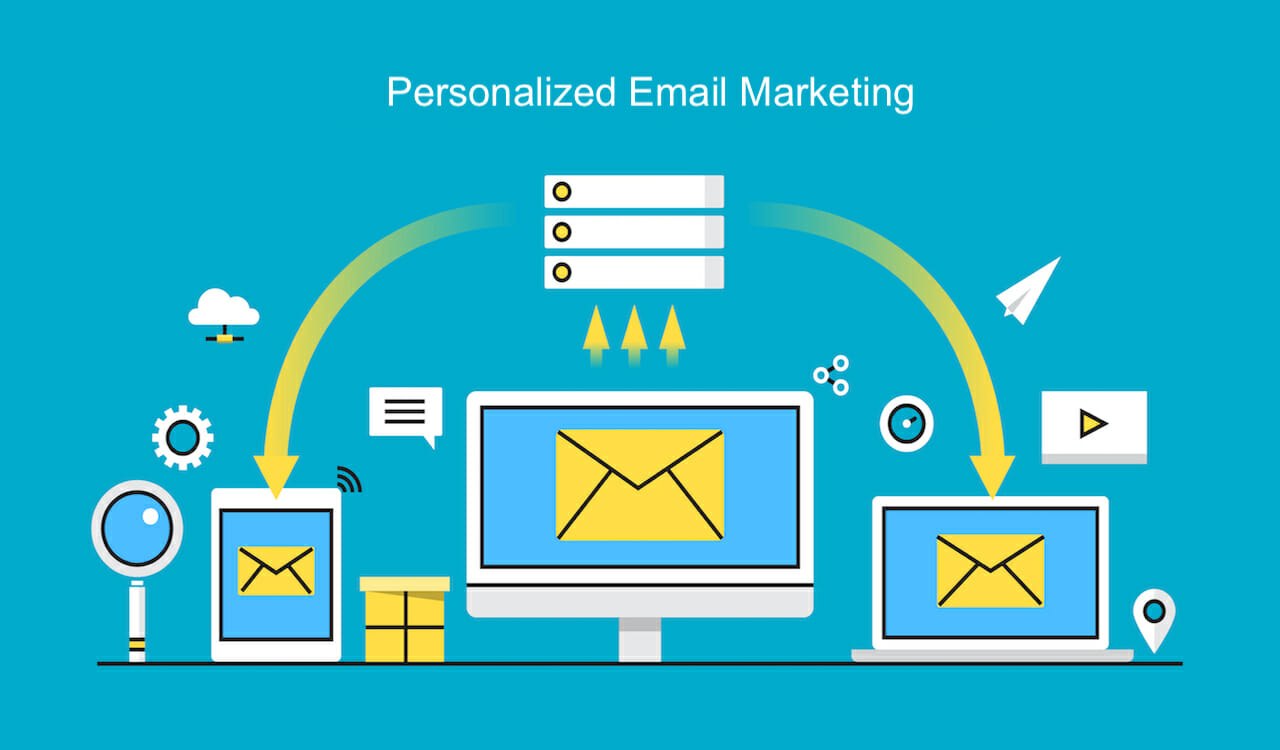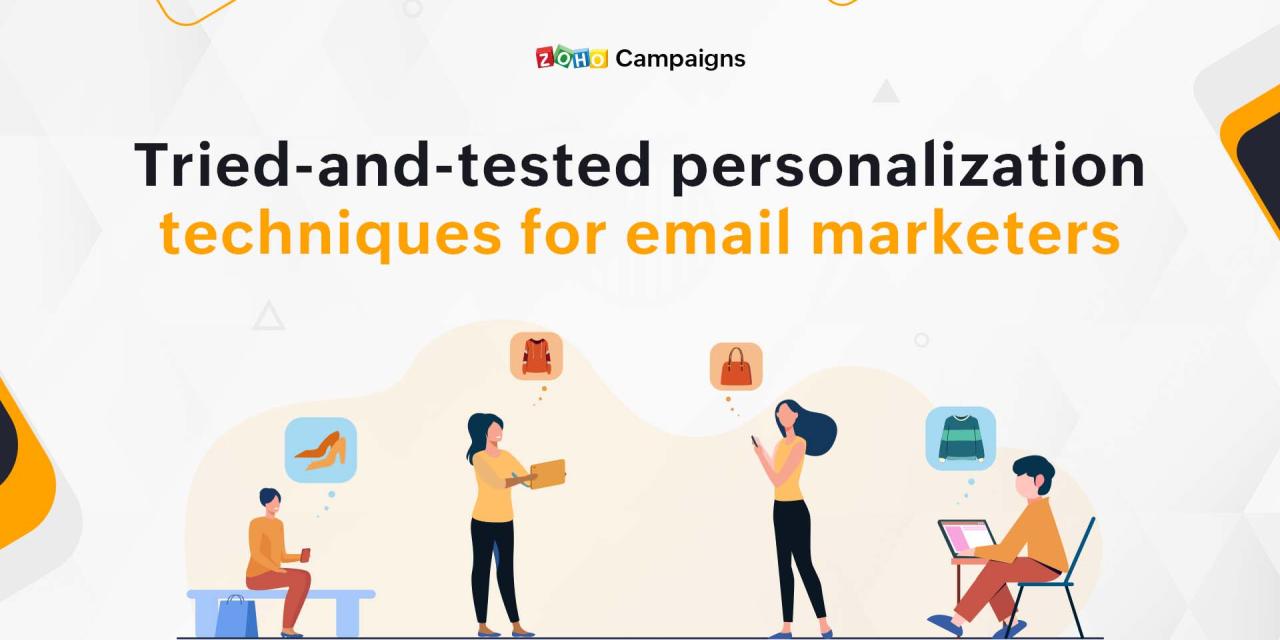Email Marketing Personalization Techniques

Beginning with Email marketing personalization techniques, unlock the power of personalized strategies to enhance your email campaigns and connect with your audience on a deeper level.
Personalization is key in today’s digital landscape, where tailored content can make a significant impact on engagement and conversion rates. By implementing segmentation strategies, dynamic content customization, personalized subject lines, and automation, you can create compelling email campaigns that resonate with your subscribers.
Introduction to Email Marketing Personalization Techniques

Personalization in email marketing is crucial for creating a more engaging and targeted experience for your audience. By tailoring your emails to the individual preferences and behaviors of your subscribers, you can increase open rates, click-through rates, and ultimately, conversions.
One successful example of email personalization is Amazon’s recommendation emails, which are based on the user’s browsing and purchase history. By suggesting products that are relevant to each customer, Amazon is able to drive more sales and enhance the customer experience.
Benefits of Incorporating Personalization
- Improved Engagement: Personalized emails are more likely to capture the attention of recipients and encourage them to take action.
- Increased Conversions: By delivering relevant content to each subscriber, you can boost conversion rates and drive more sales.
- Enhanced Customer Experience: Personalization shows that you understand and value your customers, leading to stronger relationships and loyalty.
- Higher ROI: When done right, personalization can deliver a higher return on investment compared to generic email campaigns.
Segmentation Strategies

Segmentation plays a crucial role in personalizing email marketing campaigns to target specific audiences effectively. By dividing your email list into segments based on various criteria, you can tailor your content to meet the specific needs and preferences of each group, ultimately leading to higher engagement and conversion rates.
Demographic Segmentation
Demographic segmentation involves dividing your email list based on demographic factors such as age, gender, income, location, or occupation. For example, a clothing retailer can send personalized emails featuring different styles based on age group or gender preferences.
Behavioral Segmentation
Behavioral segmentation focuses on the actions and interactions of subscribers with your emails and website. This can include past purchases, email engagement rates, browsing history, or cart abandonment. By analyzing these behaviors, you can send targeted emails with relevant product recommendations or exclusive offers.
Psychographic Segmentation
Psychographic segmentation categorizes subscribers based on their lifestyle, values, interests, and personality traits. This type of segmentation allows you to create content that resonates with the emotions and motivations of your audience. For instance, a travel company can segment their list based on adventure-seekers, luxury travelers, or budget-conscious vacationers.
Engagement Segmentation
Engagement segmentation divides subscribers based on their level of interaction with your emails. This can include open rates, click-through rates, or frequency of engagement. By targeting highly engaged subscribers with special rewards or incentives, you can nurture customer loyalty and increase conversion rates.
Segmented email marketing has a significant impact on engagement and conversion rates by delivering relevant content to the right audience at the right time. By implementing effective segmentation strategies, you can enhance the overall effectiveness of your email campaigns and build stronger relationships with your subscribers.
Dynamic Content Customization

Dynamic content customization in email marketing allows for a more personalized approach to engaging with recipients. By tailoring email messages to individual preferences and behaviors, brands can create a more meaningful connection with their audience. This level of personalization can lead to higher engagement rates, increased conversions, and ultimately, stronger customer loyalty.
Techniques for Dynamic Content Customization
- Utilize recipient data: Collect and analyze data on recipient behavior, preferences, and interactions with previous emails to tailor content accordingly.
- Segmentation: Divide your email list into smaller segments based on demographics, behavior, or interests to send targeted messages that resonate with each group.
- Dynamic product recommendations: Use AI algorithms to suggest products or services based on recipient browsing history, purchase behavior, or preferences.
- Personalized subject lines and CTAs: Customize subject lines and calls-to-action to appeal to individual recipients and increase open and click-through rates.
Role of AI and Machine Learning, Email marketing personalization techniques
AI and machine learning play a crucial role in enabling dynamic content personalization in email marketing. These technologies can analyze vast amounts of data in real-time to deliver personalized content at scale. By leveraging AI algorithms, marketers can create relevant and timely messages that resonate with each recipient on a one-to-one level. This level of personalization not only enhances the overall user experience but also improves the effectiveness of email marketing campaigns.
Personalized Subject Lines and Preheaders

Personalized subject lines and preheaders play a crucial role in email marketing as they are the first elements that recipients see when they receive an email. They are key components in capturing the attention of the audience and enticing them to open the email.
Crafting Personalized Subject Lines for Increased Open Rates
When crafting personalized subject lines, it is important to make them relevant to the recipient. Use their name, location, or past interactions to create a sense of personalization. Keep the subject line concise and engaging, avoiding generic phrases that may not catch the recipient’s eye. A/B testing can also be utilized to determine which subject lines are more effective in increasing open rates.
Tailoring Preheaders for Better Engagement
Preheaders are often overlooked in email marketing, but they are a valuable opportunity to provide additional context to the subject line and entice recipients to open the email. Tailor the preheader to complement the personalized subject line by providing a sneak peek of what the email contains or creating a sense of urgency. Make sure the preheader is concise and compelling to encourage recipients to open the email.
Behavioral Triggers and Automation

Behavioral triggers play a crucial role in personalizing email content by allowing marketers to send messages based on specific actions or behaviors exhibited by the recipients. By leveraging user behavior data, marketers can create highly targeted and relevant email campaigns that cater to the individual preferences and interests of each subscriber.
Effective Automated Email Campaign Examples
- Abandoned Cart Emails: Sending automated emails to users who have abandoned their shopping carts can help drive conversions by reminding them of the items left behind and encouraging them to complete their purchase.
- Product Recommendations: Utilizing behavioral data such as past purchases or browsing history to suggest relevant products to customers can enhance their shopping experience and increase the likelihood of making a purchase.
- Reengagement Campaigns: Automated emails targeting inactive subscribers based on their engagement levels can help rekindle their interest in your brand and encourage them to reengage with your content or offerings.
Role of Automation in Scaling Personalized Email Marketing Efforts
Automation plays a key role in scaling personalized email marketing efforts by streamlining the process of sending targeted messages to a large audience. By setting up automated workflows triggered by specific user actions or criteria, marketers can efficiently deliver personalized content at scale without the need for manual intervention. This not only saves time and resources but also ensures that each subscriber receives relevant and timely emails tailored to their preferences and behavior.
Answers to Common Questions: Email Marketing Personalization Techniques
How important is personalization in email marketing?
Personalization in email marketing is crucial as it helps in creating relevant and targeted content that resonates with subscribers, leading to higher engagement and conversion rates.
Can you provide examples of effective segmentation criteria for email campaigns?
Segmentation criteria can include demographics, behavior, purchase history, and engagement level. By segmenting your email list based on these factors, you can deliver more personalized content to your audience.
What role does dynamic content customization play in email marketing?
Dynamic content customization allows you to tailor email messages based on recipient data, ensuring that each subscriber receives content that is relevant to their preferences and behaviors.
How can personalized subject lines and preheaders improve email open rates?
Personalized subject lines and preheaders grab the recipient’s attention and entice them to open the email. By crafting personalized subject lines that resonate with the recipient, you can significantly increase open rates.
Why is automation important in scaling personalized email marketing efforts?
Automation streamlines the process of delivering personalized content at scale. By setting up automated email campaigns based on user behavior, you can ensure that your audience receives timely and relevant messages without manual intervention.







